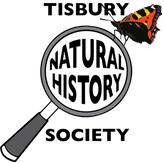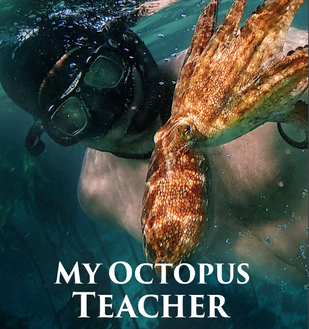|
Clive Whitbourn, National Trust Ranger, started his talk with a focus on Hambledon Hill, the 47 hectare hillfort which came to the National Trust in 2014. It is a Site of Special Scientific Interest and a photo from 1940 showed how bare the hillfort was 80 years ago. Now the hillfort is managed lightly, with scrub kept low and any erosion kept at bay with terrace reshaping to preserve the profile of the ramparts.
Clive showed us the methods they use with wooden frameworks buried deep to support hessian bags full of chalk, which bulk out any damaged areas, with turf from the ditch placed on top. The chalkland grasses grow through and thrive. He mentioned that the south and south-west ramparts of Hambledon Hill are best for butterflies. Cattle scraping for minerals – they can go on binges to self-medicate - and visitors wearing down paths, all play their part in erosion. Roboflail, a mechanical AI cutter, is being used on some of the NT sites to great effect to keep the scrub low and save the man hours for other tasks. The NT relies on volunteer help on many of their conservation projects. Hod Hill is Dorset’s largest Iron Age hillfort and is unusual because it has a Roman fort nestled within, built at a time when the invaders needed to defend their capture of this Durotriges stronghold. Clive showed us how the framework and hessian bag method was also used to repair a bridleway here. In terms of nature conservation, Texel sheep are good grazers and White Park cattle are brilliant for rough pastures. Yellow Rattle, which suppresses coarse grass growth, is doing well at Winn Green and there are plans this year to brush-harvest the seed from there and broadcast it to the newly purchased Clubmen’s Down, a 30 acre piece of arable. Across Clive’s patch and the various Downs and hillforts, uncommon species are being noted: Bee and the Great Butterfly orchids, and the unusual Autumn Lady’s Tresses; Waxcap fungi; Marsh, Silver-spotted and Danville Fritillaries, Grizzled Skippers, Small Blue and Adonis Blue butterflies; Great Green Bush-crickets and Glow worms. Clive’s talk gave us plenty of inspiration for visiting these places, particularly in the spring and summer! We shall be showing "My Octopus Teacher", a feature documentary that tells the story of how Craig Foster, following a daily routine of diving in freezing kelp forests off the tip of South Africa, discovers an unusually curious octopus that becomes a major force in his life.
Shot over a full year, this beautiful record of the octopus’s entire life explores the habits and personality of a strange, undulating creature and shows us things never before recorded by science or on film. Beyond intelligent, dextrous, and resilient, the cephalopod shares its secret world, redefining our understanding of the creatures we share our world with. Entry, free for anyone under 21, otherwise £1 for members and guests, payable at the door. Victoria Hall, High Street, Tisbury (opposite Tisbury Motors). We are fortunate to have a range of lakes and pond in the vicinity of Tisbury. These make popular destinations for walks, are great places to look for birds and at this time of year attract increased number of wildfowl which overwinter there awaiting a new breeding season.
Fonthill Lake is the largest and close to a score of waterbirds may be seen there in winter. We are all familiar with the Mute Swans, Mallard, Coots, Grey Heron and Tufted Duck which may be seen all the year round. But it is only in the winter months that the Goosanders arrive. These are quite large diving ducks of the sawbill family (so called because of the serrations on their bills used for catching fish). The male is a very handsome black and white bird with a glossy dark green head which contrasts with its bright red bill. They appear to be quite gregarious so if there are any present, they are generally all in a group rather than scattered across the lake like the swans for example. Their numbers are increasing throughout the country so we might be seeing growing numbers at Fonthill in winters to come. Another handsome bird is the Mandarin. Although the female of this neat little duck is largely brown and grey with a distinct white eye stripe, the male is much more striking with multicoloured plumage. It has a red bill, broad white eye stripe, orange ruff like feathers on the side of its neck, more orange sail-like feathers sticking up above its back and patches of purple and dark green elsewhere. If you catch a view of one in bright sunshine it looks terribly exotic. It was introduced from China (hence the name) and has naturalised after escaping from private collections. It likes lakes and ponds with lots of overhanging vegetation and can sometimes be seen sitting on branches above the water. We are becoming used to seeing Little Egrets (a small white heron with bright yellow feet and a black bill) on local lakes, ponds and watercourses so it is surprising to think that they only started colonising the UK in the late 1990s. Far less frequent but occasionally to be seen in the Nadder Valley and its waterbodies is the Great White Egret, another relatively recent colonist. It is possible to confuse these two Egrets when apart, but the Great White is much larger – the size of a Heron – and has black feet and a longer, yellow, dagger-like bill. A third species, the Cattle Egret, has also expanded its range across Europe, and first bred in the UK on the Somerset Levels in 2008. Who knows how long it will be before they are seen around here? In contrast to the Goosander, some other duck species favour salt water and winter off our coasts. However, when there is a particularly bad storm some of these might be driven inland and can turn up anywhere, so it is always worth having a close look at the wildfowl around us in winter especially after really bad weather. by Andrew Graham  Our first talk of the year will be given by National Trust Ranger Clive Whitbourn. Clive has responsibility for the day-to-day management and nature conservation of a number of the Trust’s properties near here with great landscape, archaeological, and biodiversity importance, including Hambledon Hill, Hod Hill, Fontmell Down and Melbury Down, Turnworth Woods/Ringmoor and Win Green. He will describe some of the things that make these sites so special, and also some of the challenges of managing them, both for conservation and for the enjoyment of the visiting public. The Victoria Hall, High Street, Tisbury and its bar, will be open as usual from 7:00 p.m. Members and those under 21 have free entry and we welcome any visitors to join us and pay a guest fee of £2. Please bring cash! |
Photo: Avocets (Izzy Fry)
The headers display photos taken by our members. Do get in touch via the Contact Form if you'd like to submit a photo for selection.
Archives
May 2024
Categories
All
|


 RSS Feed
RSS Feed